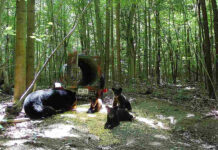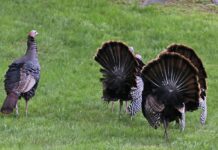Have you ever found any strange stockpiles of seeds in your home or garage? Whenever this happens, it can be hard to identify what those seeds are. Sometimes they may even appear to be insect-related and send you down a rabbit hole on the internet trying to identify this suspicious occurrence.
This exact thing happened to me this past winter. Hopefully, my research into this phenomenon will save you some time in the future if it happens to you, too.
In December, I was getting all the Christmas decorations down from the upstairs closet in our old farmhouse. We moved here about a year ago, and like any old farmhouse, there are always some unwanted guests, such as stink bugs, ladybugs and mice.
Mysterious black seeds
I stumbled upon a pile of black seeds. These seeds were about ¼ of an inch across and they were round but slightly flattened. At first, I thought they were some sort of insect eggs but was really hoping they were seeds.
They were loose in their hiding spot, but also clumped together giving them the appearance of eggs. I didn’t think much of it, just threw them away and decorated for Christmas.
A few weeks later, I was going through my son’s dresser and sorting through all the clothes that he had outgrown. Lo and behold, I opened a drawer to find yet another stash of these black seeds piled high in the back corner of the drawer around his socks.
This made me really want to figure out what was going on here.
Rodent food
After much research on the internet and through the Ohio Weed Guide, I figured out they were pokeweed seeds. Unfortunately, this means we have a rodent problem.
Mice like to gather seeds and make hoards for winter and with the abundance of pokeweed plants right behind my house, I felt satisfied I found the culprit. Lucky for me, the mystery is solved; unlucky for the poor mice who will now starve because I vacuumed up their hoard.
Common pokeweed is native to the eastern half of the United States. According to the Ohio Perennial and Biennial Weed Guide, which can be found at weedguide.cfaes.osu.edu, the distribution of this species has not been mapped in Ohio, but it appears to be widespread and is continuing to invade reduced-tillage fields.
Dangerous
Its deep tap roots make it difficult to dig up but don’t worry, it will die back with the frost. Pokeweed can reach up to 10 feet in height and has distinctly red stems and berries that change from green to dark purple when ripe.
By August, many or most of these berries have become shiny and purple and can be attractive to children who may mistake them for grapes. Although the berries may be considered a grape look alike, I wouldn’t recommend eating them.
According to poison control, eating several berries can cause pain, nausea, vomiting and diarrhea. Adults who have eaten the roots, mistaking them for medicinal plants have experienced serious gastrointestinal problems and low blood pressure.
Pokeweed is an herbaceous perennial with multiple red stems. In the spring, young pokeweed leaves can be cooked into what is called “poke salad,” but knowing how to properly prepare this salad is very important.
Leaves must be boiled and drained twice to be eaten safely, but it isn’t recommended. Can you be absolutely sure that you handled and prepared it properly? If the answer is no, then just avoid experimenting with eating any part of the plant.
Symptoms of poisoning include a burning sensation in the mouth, salivation, gastrointestinal cramps and vomiting. If larger quantities are consumed, more serious complications can occur that include anemia, convulsions and death from respiratory failure.
Just remember: A donut wouldn’t do that to you!
Toxic to pets
So, we know pokeweed is poisonous to humans, but what about pets and livestock? Well, referring back to the Perennial and Biennial Weed Guide that has determined the location of this poisonous weed to be found often in pastures, fencerows and barnyards, all parts of common pokeweed are toxic to pets and livestock.
The roots are the most poisonous; leaves and stems are intermediate in toxicity and the berries are the least toxic. According to the U.S. Department of Agriculture, cattle, horses, swine and men have all been poisoned after consuming this plant, but swine are more often affected since they often grub out the roots and eat them.
The silver lining when it comes to livestock is that they don’t find pokeweed to be very palatable, so most animals will avoid eating it if they are being fed well and have other options to choose from.
Hopefully, you don’t find too many hoards of food from our furry little friends in your home! If you have any questions regarding toxic forages or rodent control, contact your local OSU extension for more information.














There is someone on line telling people to eat 8 red poke berries a day for 3 days to stop arthritis pain. This article says they will really hurt you. What is true?
The University of Tennessee has an informative article that goes into more depth of medicinal uses of pokeweed. You can find it here: https://mcclungmuseum.utk.edu/2020/04/08/plant-of-the-month-pokeweed/
The U.S. Forest Department has also written an article concerning pokeweed : “This species may flower year around in southern states, and May to October in northern states. The entire plant is poisonous causing a variety of symptoms, including death in rare cases. The berries are especially poisonous. Young leaves and stems when properly cooked are edible and provide a good source of protein, fat and carbohydrate.” You can find the full article here: https://www.fs.usda.gov/wildflowers/plant-of-the-week/phytolacca_americana.shtml#:~:text=The%20entire%20plant%20is%20poisonous,of%20protein%2C%20fat%20and%20carbohydrate.
The common theme with the articles I have found from sources that are reputable and ending with edu or gov is that only young plants should be used and only if they are used properly, i.e. using to soak aching muscles or as poultices. The older and more mature a plant is the more poisonous it is. The berries come from a mature plant, therefore the safety of eating the berries, I would find questionable.